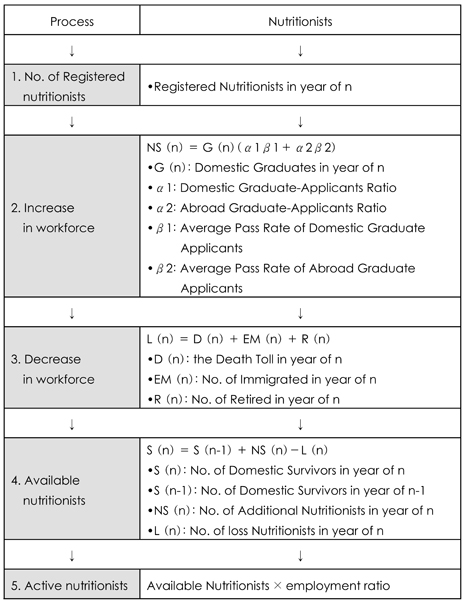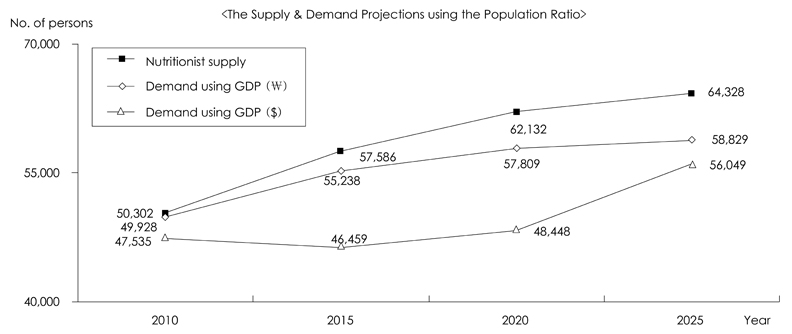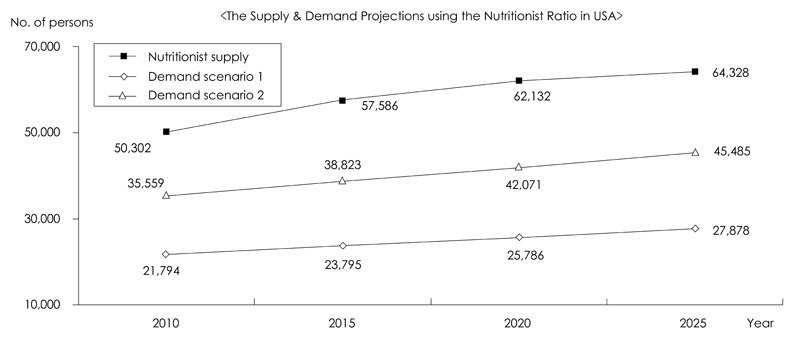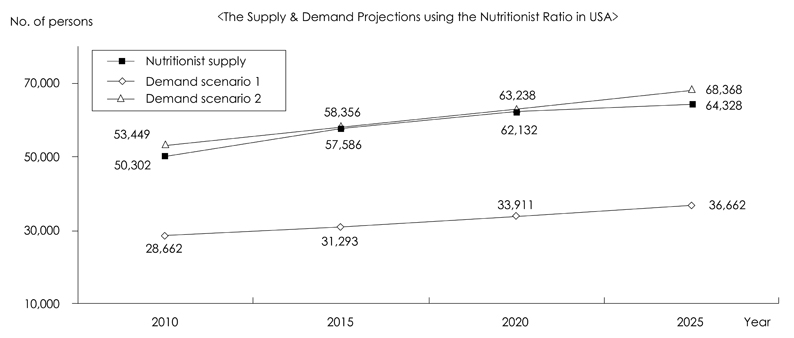Korean J Nutr.
2010 Oct;43(5):533-542. 10.4163/kjn.2010.43.5.533.
The Demand and Supply of Nutritionist Workforce in Korea and Policy Recommendations
- Affiliations
-
- 1Health Policy Research Division, Korea Institute for Health & Social Affairs, Seoul 122-705, Korea. ohyho@kihasa.re.kr
- KMID: 2268050
- DOI: http://doi.org/10.4163/kjn.2010.43.5.533
Abstract
- The objective of this study is to provide basic information and policy implications needed to balance the supply and demand for dietitian by projecting supply and demand for dietitian. The data from the Ministry of Health Welfare and Family on the number of licensed nutritionist, resident registration data of the Ministry of Public Administration and Security, and health insurance qualification data of the National Health Insurance Corporation were used to examine the current status of supply. To project the supply of nutritionist workforce, the in-out moves method and demographic method were used. The ratios of nutritionist to population and GDP, and that of other countries were applied as the demand projection method. According to the study results, the projection on the imbalance of supply and demand for dietitian by year 2021 differs depending on the method used. First, according to the results based on age-adjusted population ratio, there is an oversupply of 1,643 dietitians in year 2010, and 2,076 dietitians in year 2020. Second, although the projection on the imbalance of the supply and demand for dietitian differs depending on whether the GDD is calculated in won(won) or dollar($). it is expected that there will be an oversupply in general. Third, as to the scenario using the nutritionist ratio in foreign countries, the oversupply of dietitian is likely in Korea, under any scenario, when comparing the nutritionist supply projection with the demand projection based on the nutritionist ratio in the United States. However, the projection of the supply and demand varies in each scenario when the European nutritionist ratio is applied. Under European 'scenario 1', an oversupply is expected, whereas under 'scenario 2', a shortage of supply is expected. A careful approach is required in interpreting the supply and demand projection using criteria of other countries, because dietitian assumes different roles and functions in each country. Although a slight oversupply of nutritionist workforce is projected, it does not cause a major problem as the demand for diet therapy is expected to rise due to aging and the increase of chronic diseases, and as the demand for clinical dietitians in hospitals increases. Accordingly, the demand for dietitians will rise and, in this context, the oversupply of nutritionist will not incur much problem. However, the nutritionist qualification is much too open in Korea, and this has a negative effect on the quality of the nutritionist workforce. Therefore, it is important that the nutritionist qualifications and requirements are reinforced in the future, enhance the quality level of the nutritionist supply, and maintain the balance between the supply and demand.
MeSH Terms
Figure
Reference
-
1. The Korea Centers for Disease Control and Prevention (KCDC). The 2nd Adolescence Health Policy Forum. 2007.2. Maillet JO. Dietetics in 2017: What does the future hold? J Am Diet Assoc. 2002. 102(10):1404–1406.3. Kim HR, Yun JH, Park HR, Kim EJN, Kwon SH. A Study on Prospect of Supply and Demand for Public Health Nutritionists in National Health Promotion Program. 2007.4. Oh YH, Jo JG, Kim JH, Jee YG. Prospect of the Supply and Demand of Healthcare Workforce. Korea Institute for Health & Social Affairs. 2010.5. Choi EY, Jo JG, Kim JS, Lee WB. The Supply and Demand of Medical and Pharmaceutical Personnels and the Policy Implication. Korea Institute for Health & Social Affairs; . 2008.6. Oh YH, Jo JG, Lee SH, Lee SY, Park JY, Kim JH, Jee YG. Long-term Forecasting of the Healthcare Supply in Korea. Korea Institute for Health & Social Affairs. 2006.7. Hall TL, Mejia A. Health Manpower Planning: Principles, Methods, Issues. 1978. Geneva: WHO.8. Greenberg L, Cultice JM. Forecasting the Needs for Physicians in the United States: The Health Resources and Services Administration's Physician Requirement Model. Health Serv Res. 1997. 31(6):723–737.9. Oh YH. Prospect on the Supply and Demand of Physician, Dentists, Oriental Herb Physicians. The Korean Association of Health Economics and Policy. 2008.10. Bureau of Health Professions. Health Resources and Services Administration. Public Health Workforce. 2005. http://bhpr.hrsa.gov/healthworkforce/reports/publichealth/.11. Kaufman M. Personnel in Public Health Nutrition for the 1990s. 1991. Washington, D.C: The Public Health Foundation.12. Kaufman M, editor. Personnel in Public Health Nutrition for the 1980s. ASTHO Foundation. 1982.13. American Dietetic Association Commission on Dietetic Registration. . Compensation & Benefits Survey of the Dietetics Profession. 2005. Chicago: American Dietetic Association.14. ADA. The American Dietetic Association Accreditation Approval Manual. 1991.
- Full Text Links
- Actions
-
Cited
- CITED
-
- Close
- Share
- Similar articles
-
- Development of a Demand Model for Physician Workforce Projection on Regional Inequity Problem in Korea Using System Dynamics
- A Comparative Analysis for Projection Models of the Physician Demand and Supply Among 5 Countries
- Appropriate Adjustment according to the Supply and Demand Status and Trend of Doctors
- Current Situation and the Forecast of the Supply and Demand of the Nursing Workforce in Korea
- An Estimation of Supply and Demand for Primary Healthcare Nursing Workforce in the North Korean Region after Korean Reunification






